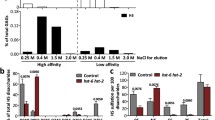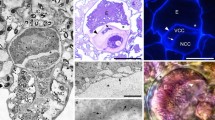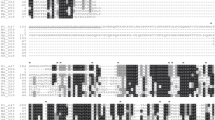Abstract
Arylsulfatases (Arses) have been regarded as lysosomal enzymes because of their hydrolytic activities on synthetic aromatic substrates and their lysosomal localization of their enzymatic activities. Using sea urchin embryos, we previously demonstrated that the bulk of Hemicentrotus Ars (HpArs) does not exhibit enzyme activity and is located on the apical surface of the epithelial cells co-localizing with sulfated polysaccharides. Here we show that HpArs strongly binds to sulfated polysaccharides and that repression of the synthesis by HpArs-morpholino results in retardation of gastrulation in the sea urchin embryo. Accumulation of HpArs protein and sulfated polysaccharides on the apical surface of the epithelial cells in sea urchin larvae is repressed by treatment with β-aminopropionitrile (BAPN), suggesting that deposition of HpArs and sulfated polysaccharides is dependent on the crosslinking of proteins such as collagen-like molecules. We suggest that HpArs functions by binding to components of the extracellular matrix.



Similar content being viewed by others
References
Adelson DL, Humphreys T (1988) Sea urchin morphogenesis and cell-hyalin adhesion are perturbed by a monoclonal antibody specific for hyalin. Development 104:391–402
Akasaka K, Terayama H (1983) Sulfated glycan present in the EDTA extract of Hemicentrotus embryos (mid-gastrula). Exp Cell Res 146:177–185
Akasaka K, Terayama H (1984) A proteoglycan fraction isolated from the EDTA extract of sea urchin (Hemicentrotus pulcherrimus) gastrulae stimulates reaggregation of dissociated embryonic cells. Exp Cell Res 150:226–233
Akasaka K, Akimoto Y, Sato M, Hirano H, Shimada H (1990) Histochemical detection of arylsulfatase activity in sea urchin embryos. Dev Growth Differ 32:293–298
Akasaka K, Uemoto H, Wilt F, Mitsunaga-Nakatsubo K, Shimada H (1997) Oral-aboral ectoderm differentiation of sea urchin embryos is disrupted in response to calcium ionophore. Dev Growth Differ 39:373–379
Alliegro MC, Ettensohn CA, Burdsal CA, Erickson HP, McClay DR (1988) Echinonectin: a new embryonic substrate adhesion protein. J Cell Biol 107:2319–2327
Benson S, Rawson R, Killian C, Wilt F (1991) Role of the extracellular matrix in tissue-specific gene expression in the sea urchin embryo. Mol Reprod Dev 29:220–226
Bisgrove BW, Raff RA (1993) The SpEGF III gene encodes a member of the fibropellins: EGF repeat-containing proteins that form the apical lamina of the sea urchin embryo. Dev Biol 157:526–538
Burke RD, Myers RL, Sexton TL, Jackson C (1991) Cell movements during the initial phase of gastrulation in the sea urchin embryo. Dev Biol 146:542–557
Butler E, Hardin J, Benson S (1987) The role of lysyl oxidase and collagen crosslinking during sea urchin development. Exp Cell Res 173:174–182
Coffman JA, McClay DR (1990) A hyaline layer protein that becomes localized to the oral ectoderm and foregut of sea urchin embryos. Dev Biol 140:93–104
Csiszar K (2001) Lysyl oxidases: a novel multifunctional amine oxidase family. Prog Nucleic Acid Res Mol Biol 70:1–32
Davidson LA, Koehl MAR, Keller R, Oster GF (1995) How do sea urchins invaginate? Using biomechanics to distinguish between mechanisms of primary invagination. Development 121:2005–2018
Davidson LA, Oster GF, Keller RE, Koehl MA (1999) Measurements of mechanical properties of the blastula wall reveal which hypothesized mechanisms of primary invagination are physically plausible in the sea urchin Strongylocentrotus purpuratus. Dev Biol 209:221–238
Delehedde M, Lyon M, Sergeant N, Rahmoune H, Fernig DG (2001) Proteoglycans: pericellular and cell surface multireceptors that integrate external stimuli in the mammary gland. J Mammary Gland Biol Neoplasia 6:253–273
Ettensohn CA (1985) Gastrulation in the sea urchin embryo is accompanied by the rearrangement of invaginating epithelial cells. Dev Biol 112:383–390
Ettensohn CA (1999) Cell movements in the sea urchin embryo. Curr Opin Genet Dev 9:461–465
Evers M, Saftig P, Schmidt P, Hafner A, McLoghlin DB, Schmahl W, Hess B, von Figura K, Peters C (1996) Targeted disruption of the arylsulfatase B gene results in mice resembling the phenotype of mucopolysaccharidosis VI. Proc Natl Acad Sci U S A 93:8214–8219
Fuchikami T, Mitsunaga-Nakatsubo K, Amemiya S, Hosomi T, Watanabe T, Kurokawa D, Kataoka M, Harada Y, Satoh N, Kusunoki S, Takata K, Shimotori T, Yamamoto T, Sakamoto N, Shimada H, Akasaka K (2002) T-brain homologue (HpTb) is involved in the archenteron induction signals of micromere descendant cells in the sea urchin embryo. Development 129:5205–5216
Ghosh D (2007) Human sulfatases: a structural perspective to catalysis. Cell Mol Life Sci 64:2013–2022
Hanson SR, Best MD, Wong CH (2004) Sulfatases: structure, mechanism, biological activity, inhibition, and synthetic utility. Angew Chem Int Ed Engl 43:5736–5763
Hibino T, Harada Y, Minokawa T, Nonaka M, Amemiya S (2004) Molecular heterotopy in the expression of Brachyury orthologs in order Clypeasteroida (irregular sea urchins) and order Echinoida (regular sea urchins). Dev Genes Evol 214:546–558
Kagan HM, Li W (2003) Lysyl oxidase: properties, specificity, and biological roles inside and outside of the cell. J Cell Biochem 88:660–672
Kominami T, Takata H (2000) Cellular basis of gastrulation in the sand dollar Scaphechinus mirabilis. Biol Bull 199:287–297
Kominami T, Takata H (2004) Gastrulation in the sea urchin embryo: a model system for analyzing the morphogenesis of a monolayered epithelium. Dev Growth Differ 46:309–326
McClay DR, Gross JM, Range R, Peterson RE, Bradham C (2004) Sea urchin gastrulation. In: Stern CD (ed) Gastrulation: from cells to embryo. Cold Spring Harbor Laboratory, Cold Spring Harbor, pp 123–137
Mehl E, Jatzkewitz H (1968) Cerebroside 3-sulfate as a physiological substrate of arylsulfatase A. Biochim Biophys Acta 151:619–627
Miller DJ, Macek MB, Shur BD (1992) Complementarity between sperm surface β-1,4-galactosyltransferase and egg-coat ZP3 mediates sperm-egg binding. Nature 357:589–593
Mitsunaga-Nakatsubo K, Akasaka K, Akimoto Y, Akiba E, Kitajima T, Tomita M, Hirano H, Shimada H (1998) Arylsulfatase exists as non-enzymatic cell surface protein in sea urchin embryos. J Exp Zool 280:220–230
Parenti G, Meroni G, Ballabio A (1997) The sulfatase gene family. Curr Opin Genet Dev Cell 7:386–391
Pinnell SR, Martin GR (1968) The cross-linking of collagen and elastin: enzymatic conversion of lysine in peptide linkage to alpha-aminoadipic-delta-semialdehyde (allysine) by an extract from bone. Proc Natl Acad Sci U S A 61:708–716
Rapraeger AC, Epel D (1981) The appearance of an extracellular arylsulfatase during morphogenesis of the sea urchin Strongylocentrotus purpuratus. Dev Biol 88:269–278
Sasaki H, Akasaka K, Shimada H, Shiroya T (1987) Purification and characterization of arylsulfatase from sea urchin embryo. Comp Biochem Biophys 88B:147–152
Sasaki H, Yamada K, Akasaka K, Kawasaki H, Suzuki K, Saito A, Sato M, Shimada H (1988) cDNA cloning, nucleotide sequence and expression of the gene for arylsulfatase in the sea urchin (Hemicentrotus pulcherrimus) embryo. Eur J Biochem 177:9–13
Scott JE, Orford CR (1981) Dermatan sulphate-rich proteoglycan associates with rat tail-tendon collagen at the d band in the gap region. Biochem J 197:213–216
Spiegel E, Spiegel M (1979) The hyaline layer is a collagen-containing extracellular matrix in sea urchin embryos and reaggregating cells. Exp Cell Res 123:434–441
Takata H, Kominami T (2001) Ectoderm exerts the driving force for gastrulation in the sand dollar Scaphechinus mirabilis. Dev Growth Differ 43:265–274
Tang SS, Trackman PC, Kagan HM (1983) Reaction of aortic lysyl oxidase with β-aminopropionitrile. J Biol Chem 258:4331–4338
Wessel GM, McClay DR (1987) Gastrulation in the sea urchin embryo requires the deposition of crosslinked collagen within the extracellular matrix. Dev Biol 121:149–165
Wessel GM, Wikramanayake A (1999) How to grow a gut: ontogeny of the endoderm in the sea urchin embryo. Bioessays 21:459–471
Wessel GM, Zhang W, Tomlinson CR, Lennarz WJ, Klein WH (1989) Transcription of the Spec 1-like gene of Lytechinus is selectively inhibited in response to disruption of the extracellular matrix. Development 106:355–365
Wessel GM, Berg L, Adelson DL, Cannon G, McClay DR (1998) A molecular analysis of hyalin-a substrate for cell adhesion in the hyaline layer of the sea urchin embryo. Dev Biol 193:115–126
Yogalingam G, Litjens T, Bielicki J, Crawley AC, Muller V, Anson DS, Hopwood JJ (1996) Feline mucopolysaccharidosis type VI. Characterization of recombinant N-acetylgalactosamine 4-sulfatase and identification of a mutation causing the disease. J Biol Chem 271:27259–27265
Acknowledgements
The authors express their thanks to Dr. Fred H. Wilt for his advice in preparation and critical reading of the manuscript. This work was supported in part by Grants-in-Aid for Scientific Research (No. 14658239) and for Scientific Research on Priority Areas (11152227) to K.A. from the Ministry of Education, Science, Sports, and Culture, Japan, and the Hayashi Memorial Foundation for Female Natural Scientists to K. M.-N. (02R99).
Author information
Authors and Affiliations
Corresponding author
Additional information
Communicated by V. Hartenstein
Rights and permissions
About this article
Cite this article
Mitsunaga-Nakatsubo, K., Akimoto, Y., Kawakami, H. et al. Sea urchin arylsulfatase, an extracellular matrix component, is involved in gastrulation during embryogenesis. Dev Genes Evol 219, 281–288 (2009). https://doi.org/10.1007/s00427-009-0289-5
Received:
Accepted:
Published:
Issue Date:
DOI: https://doi.org/10.1007/s00427-009-0289-5




